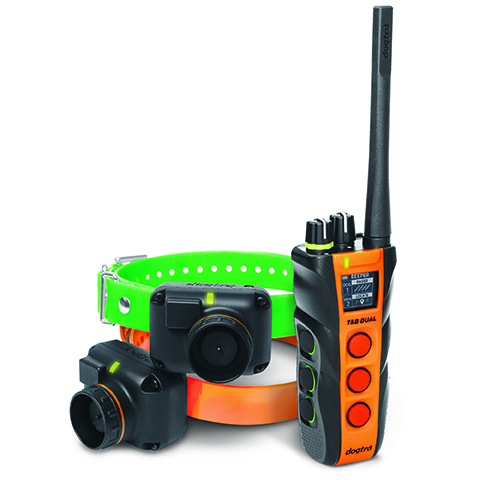There is no better training tool than a properly used e-collar, but used incorrectly there is no worse tool. Here’s what you need to know.
This has become a very volatile issue over the years, and anyone that speaks openly regarding e-collar training becomes an easy target. I do not mind sticking my neck out and I am confident in my e-collar knowledge regarding its proper use. However, you need to understand my stance on e-collars.
This is the most important rule: If you don’t want to use an e-collar, don’t!
Dog trainers have been training dogs without e-collars for years. It can still be done today. You just need to realize that if you do not use an e-collar, some other form of pressure/correction will be needed.
Historically, harsher methods of correction such as whips, brute force and even shooting dogs have been used. Over time, it has shifted to more “humane” methods such as behavior-based methods. Make no mistake about it, though, at some point all talented dogs will challenge you and need to be corrected. Because the e-collar keeps my hands off of the dog during a correction, I am of the opinion it is the best training tool — particularly for “soft” dogs.
I am an e-collar trainer. I believe that there is no better training tool than a properly used e-collar, but used incorrectly there is no worse training tool. Although it could never be enforced, I believe people should have to demonstrate a proficiency in their use to be allowed to use an e-collar.
Craney Hill Kennel, like many professional kennels, conducts training seminars that include sessions on the proper use of an e-collar. There are many ways to correctly use one.
For example, we use a combination of continuous and momentary stimulation. The retriever world primarily uses a technique known as indirect pressure. There are terms such as positive (the term that television and movies promote) and negative.
Ask the Right Questions
If you want to learn to use an e-collar properly, contact a professional trainer and go watch them use it. You should be able to tell if they are good with it or not. Ask them if they have put the collar on their neck, ankle, wrist, etc. Ask if they have put a bark collar on their neck and barked to test it. Ask which manufacturer they use and suggest. Do they only use one collar or do they have many products that they use?
These questions are important because if they do not try the collars on themselves, how can they begin to understand how they work? How do they know that when it is put just under your chin the stimulation can be felt, but when it is moved a quarter of an inch to the side it can no longer be felt? Do you think that this might be important when making flash decisions as to whether or not to increase the stimulation level on a dog that may be ignoring the stimulation, or may not feel the stimulation at all?
Does the trainer trust the light on the transmitter unit or does he trust the dog? Does the trainer know that on some collars there is a delay from when you push a stimulation button until the stimulation turns on?
Likewise, does he know that on some models there is a delay when it turns off? Does the trainer know what the lowest stimulation level is that the dog actually feels?
I could go on and on with questions because I have personally tested all of this information. I know which collars have true continuous stimulation and which ones do not. I know which collars turn off after eight seconds and which ones turn off after ten seconds. I know which collars are on a digital frequency. I know that the packaging that indicates the range that each collar has is typically not accurate in the field.
More importantly, if the e-collar has a range of one mile, who can see their dog one mile away? And if you cannot see your dog, why would you be stimulating it?
Key Features of E-Collar Training
Now that you all will seek professional help with an e-collar, I will climb off my soapbox and start to tell you about them. I want to talk about some of the many features that e-collars have and which features I believe are most important. I do not care which company makes the collar; I want to use the collar that I think is best for the way I train.
Here are 5 important features to consider:
1. Almost all e-collars now have variable stimulation of at least seven levels. Your dog will certainly be able to be trained with one of the levels of stimulation. Remember that a Level 1 on e-collar A may be “hotter” or “softer” than Level 1 on e-collar B. The collars that work best for us are the ones that have a “jump or boost” feature. This means that I have a button that will stimulate the dog at one level and another button that will stimulate the dog at a higher level without having to move the stimulation level dial to another level.
2. I want an e-collar that offers true continuous stimulation. This means that when the stimulation is turned on, I want it to stay on when I increase the stimulation level. The stimulation on many e-collars actually turns off when you increase the stimulation level; you have to take your finger off the button and restart the stimulation.
3. People should only consider e-collars that have both a waterproof receiver and a waterproof transmitter.
4. Most e-collars now use rechargeable batteries. Those are the ones you want.
5. I do not use vibration, tone or any other “positive” feature. This is a concession the manufacturers have made to try to improve public opinion. The fact is that I train bird dogs, and if anyone thinks that a tone or a vibration is going to stop a bird dog in the cattail slough when it is hot on a pheasant, they are mistaken. If a dog comes off of that pheasant due to a vibration or some other “positive” tone, then I do not want that dog!
These are the features you will want to think about. E-collars generally fit on the dog the same way regardless of the manufacturer. It should be snug enough so that you can just slide two fingers under the collar.
If you spend some time doing research, you will make a wise purchase decision. Spend most of your time researching someone that you can learn from.
Do not believe people that say you cannot use an e-collar around birds or in other situations. We use an e-collar in all scenarios. We have even stimulated dogs with a bird in their mouth. If used properly, you can use an e-collar in all situations and have a dog that is exciting.
A dog will not show evidence that it was trained with an e-collar. When we hold out an e-collar at the front of the kennel, our dogs run up front to put their head through the collar. Now that’s what I call positive training!
 Archibald Rutledge has long been recognized as one of the finest sporting scribes this country has ever produced. A prolific writer who specialized in stories on nature and hunting, over the course of a long and prolific career Rutledge produced more than fifty books of poetry and prose, held the position of South Carolina’s poet laureate for thirty-three years, and garnered numerous honorary degrees and prizes for his writings. In this revised and expanded edition of Bird Dog Days, Wingshooting Ways, noted outdoor writer Jim Casada draws together Rutledge’s stories on the southern heartland, deer hunting, turkey hunting, and Carolina Christmas hunts and traditions. Shop Now
Archibald Rutledge has long been recognized as one of the finest sporting scribes this country has ever produced. A prolific writer who specialized in stories on nature and hunting, over the course of a long and prolific career Rutledge produced more than fifty books of poetry and prose, held the position of South Carolina’s poet laureate for thirty-three years, and garnered numerous honorary degrees and prizes for his writings. In this revised and expanded edition of Bird Dog Days, Wingshooting Ways, noted outdoor writer Jim Casada draws together Rutledge’s stories on the southern heartland, deer hunting, turkey hunting, and Carolina Christmas hunts and traditions. Shop Now




